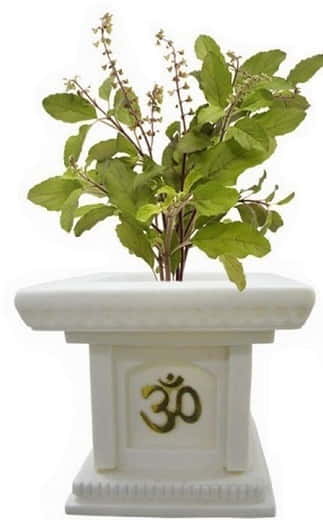About Tulsi Plant
Share this post
Hindu religion has bestowed ‘Tulsi’, with the status of mother. Also known as ‘Sacred or Holy Basil’, Tulsi, has been recognized as a religious and spiritual devout in many parts of the world. The vedic sages knew the benefits of Tulsi and that is why they personified it as a Goddess and gave a clear message to the entire community that it needs to be taken care of by the people, literate or illiterate. We try to protect it because it is like Sanjeevani for the mankind. Tulsi has great medicinal properties. It is a remarkable antibiotic. Taking Tulsi everyday in tea or otherwise increases immunity and help the drinker prevent diseases, stabilize his or her health condition, balance his or her body system and most important of all, prolong his or her life. Keeping Tulsi plant at home prevents insects and mosquitoes from entering the house. It is said that snakes do not dare to go near a Tulsi plant. Maybe that is why ancient people would grow lots of Tulsi near their houses.
The Latin name of Tulsi plant is ” Ocimum Sanctum.” It is also called as Holy Basil. In Sanskrit, tulanaa naasti athaiva tulasi - that which is incomparable (in its qualities) is the tulasi. For thousands of years, Tulsi has been worshiped by Hindus. It is considered as a sacred plant and it is necessary for every Hindu family to have a Tulsi plant in front of their house. The recent studies, have shown that Tulsi plant releases Ozone (O3) along with oxygen, which is very essential for ecological balance. World Ozone Day is celebrated on 16th September of every year, at which time some environmental organizations distribute Tulsi plants in large number. Besides that Tulsi has lots of medicinal uses and is a very important herb according to Ayurveda. Tulsi leaves strengthen our immune system. So, the Tulsi leaves has great medicinal value and are mainly used for to cure various ailments, treating fever, common cold, cough, sore throat, and respiratory disorders. In fact it is known to be the only thing used in worship, which, once used, can be washed and reused in pooja - as it is regarded so selfpurifying.
As one story goes, Tulasi was the devoted wife of Shankhachuda, a celestial being. She believed that Lord Krishna tricked her into sinning. So she cursed Him to become a stone (shaaligraama). Seeing her devotion and adhered to righteousness, the Lord blessed her saying that she would become the worshipped plant, tulasi that would adorn His head. Also that all offerings would be incomplete without the tulasi leaf - hence the worship of tulasi.
She also symbolises Goddess Lakshmi, the consort of Lord Vishnu. Those who wish to be righteous and have a happy family life worship the tulasi. Tulasi is married to the Lord with all pomp and show as in any wedding. This is because according to another legend, the Lord blessed her to be His consort. Satyabhama once weighed Lord Krishna against all her legendary wealth. The scales did not balance till a single tulasi leaf was placed along with the wealth on the scale by Rukmini with devotion. Thus the tulasi played the vital role of demonstrating to the world that even a small object offered with devotion means more to the Lord than all the wealth in the world.
It is a popular belief that Tulsi is the wife of Lord Vishnu; therefore, chewing it will be a mark of disrespect. However, botanists, in the course of their research, found that Tulsi plant has the maximum of mercury. If raw mercury is applied to teeth, they fall immediately. That’s why in Hindu religion, Tulsi leaves are not chewed but swallowed.
Why Worship Tulsi PlantSimilar Posts : Why Kajal, What is Hindu calendar, Why Lotus is special, தீர்த்தம் தருதல், Pithru Dhosha, See Also:Tulsi Hinduism

Comments